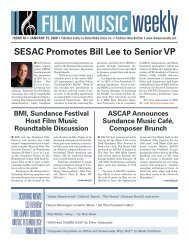February 12, 2007 - Film Music Magazine
February 12, 2007 - Film Music Magazine
February 12, 2007 - Film Music Magazine
You also want an ePaper? Increase the reach of your titles
YUMPU automatically turns print PDFs into web optimized ePapers that Google loves.
the articulation you’re trying to<br />
achieve for a specific piece. The<br />
good folks at VSL will then create<br />
a custom preset for you and<br />
explain how to use it (see the webcast<br />
announcing and enjoy Michael’s<br />
excellent Vienna rendition<br />
of a cover version of Here to Stay<br />
by the American band Korn).<br />
One of the articulations I felt<br />
was missing was the .5 in the<br />
basses, which is a kind of detache<br />
that lets you create a legato feel.<br />
So I put in my proposal for the suggested<br />
bass articulation, and within 48 hours,<br />
artistic director Michael Hula came back with<br />
a terrific solution.<br />
On January 22, VSL posted a 4-color PDF<br />
guide that’s enormously useful. You need<br />
the manual. That’s because VI uses velocity<br />
switching to change from say p to mf. You need<br />
the manual to show where those changes take<br />
place. A program can have from one to four velocity<br />
layers. And while the velocity breaks are<br />
consistent throughout the library, I prefer to<br />
have the manual just because it’s right in front<br />
of me and because of all the extra information<br />
it contains. While you can print it out in B&W,<br />
my advice is to get some 3-hole<br />
punch paper and print it out in<br />
color version. There’s a lot going<br />
on the color makes a useful difference.<br />
Kudos to David Ender who<br />
produced it.<br />
The Appassionata Strings<br />
manual isn’t on the DVD with the<br />
other manuals, installer, Syncrosoft<br />
center, etc. You have to download<br />
it from the Vienna web site<br />
in the User Area.<br />
For training, you’ll really<br />
want to spend time with the<br />
training vids on the DVD. Or, before ordering,<br />
watching them on the Vienna web site. n<br />
Peter Alexander is preparing to score The Good<br />
Samaritan. His most recent books are How Ravel<br />
Orchestrated: Mother Goose Suite, and Professional<br />
Orchestration. He has also written White Papers on<br />
music education.<br />
CONCLUSION:<br />
This is a library that’s clearly worth the time to<br />
learn. If you’ve never had a Vienna library before,<br />
start here.<br />
Red Microphones<br />
give away free mics<br />
n Red Microphones has announced a new<br />
promotion featuring their Type A and Type<br />
B interchangeable capsule microphone systems.<br />
Purchasers of a Red Type A mic and<br />
two Redhead capsules (R0 thru R7) from a<br />
local dealer will receive a free Type B mic<br />
on the spot, a $450 value.<br />
The Type A is Red’s transformerless<br />
Class A tube microphone, while the Type<br />
B is Red’s Class A discrete solid state mic.<br />
Together with Red’s family of interchangeable<br />
capsules, these systems offer a world<br />
of different sonic characteristics and pickup<br />
patterns that are readily available without<br />
even powering down.<br />
This limited time offer requires no receipts<br />
to send or forms to fill out. Customers<br />
can simply purchase a Red Type A mic<br />
and two capsules from a participating Red<br />
dealer and get a Type B mic on the spot.<br />
mn<br />
READ MORE HERE:<br />
www Purchase information and complete promotion<br />
conditions<br />
FILM MUSIC weekly ISSUE 2 • FEBRUARY <strong>12</strong>, <strong>2007</strong> 11

















